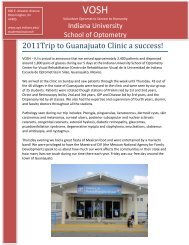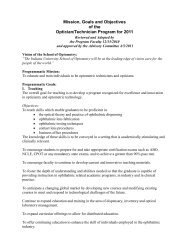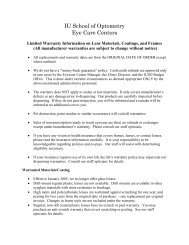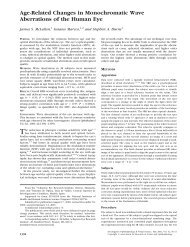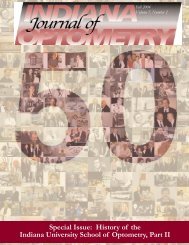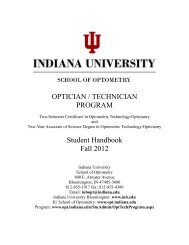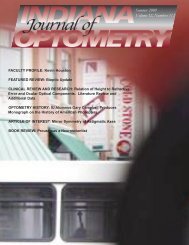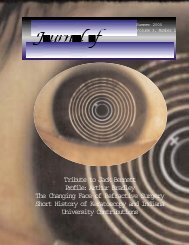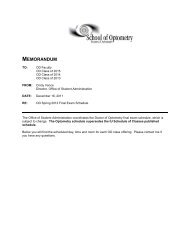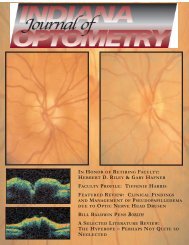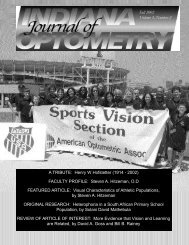Fall 2012 - Indiana University School of Optometry
Fall 2012 - Indiana University School of Optometry
Fall 2012 - Indiana University School of Optometry
Create successful ePaper yourself
Turn your PDF publications into a flip-book with our unique Google optimized e-Paper software.
presented in D/Δ obtained by dividing those reported in<br />
D/MA by an arbitrary value <strong>of</strong> 6.<br />
Studies Measuring CA/C Ratios Using Optometers<br />
or Autorefractors<br />
Most studies in the literature reporting CA/C ratios have<br />
used an optometer or open-field autorefractor to<br />
measure accommodation. Published values have shown<br />
some variation. Examples <strong>of</strong> the mean CA/C ratios<br />
from studies that used an optometer or refractometer to<br />
measure accommodation are:<br />
(a) Kent, 7 0.13 D/Δ (17 subjects, 9.5 to 48 years <strong>of</strong> age,<br />
SD <strong>of</strong> CA/C = 0.06);<br />
(b) Hung et al., 8 0.12 D/Δ (22 asymptomatic subjects,<br />
18 to 24 years old, SD = 0.05);<br />
(c) Hung et al., 8 0.11 DΔ (21 symptomatic subjects, 19<br />
to 30 years old, SD = 0.05);<br />
(d) Rosenfield and Gilmartin, 9 0.06 D/Δ (30 young<br />
adult subjects);<br />
(e) Kotulak et al., 10 0.10 D/Δ (16 subjects, mean age =<br />
25.4 years; SD <strong>of</strong> CA/C = 0.08);<br />
(f) Nonaka et al., 11 0.08 D/Δ (78 patients with<br />
exophoria or intermittent exotropia, mean age = 12.9<br />
years, SD <strong>of</strong> CA/C = 0.04);<br />
(g) Brautaset and Jennings, 12 0.14 D/Δ (10 subjects<br />
with convergence insufficiency, mean age = 25 years,<br />
SD <strong>of</strong> CA/C = 0.02); and<br />
(h) Fukushima et al., 13 0.09 D/Δ (16 subjects, ages 22<br />
to 25 years, SD = 0.04).<br />
The variability in results from different studies could be<br />
explained by differences in methods <strong>of</strong> measuring<br />
accommodation, in ages <strong>of</strong> subjects, in amounts <strong>of</strong><br />
convergence or divergence stimulated, in time over<br />
which vergence adaptation may have occurred, and in<br />
visual characteristics <strong>of</strong> the subjects. Some <strong>of</strong> those<br />
studies reported stimulus CA/C ratios (change in<br />
convergence stimulus in the denominator) and some<br />
reported response CA/C ratios (change in convergence<br />
response in the denominator). However, because there<br />
is typically little difference between vergence stimulus<br />
and vergence response, it is expected that there will be<br />
little difference between stimulus CA/C ratios and<br />
response CA/C ratios. CA/C ratio appears to decrease<br />
with decreases in amplitude <strong>of</strong> accommodation, when<br />
the amplitude is less than about 10 D. 7 Thus in adults,<br />
CA/C ratio shows a negative correlation with age. 14<br />
Studies Measuring CA/C Ratios Using the BCC Test<br />
or Dynamic Retinoscopy<br />
Schor and Narayan 1 reported CA/C ratios with three<br />
different methods <strong>of</strong> measuring accommodation on five<br />
subjects. Accommodation measurements were taken<br />
with the BCC test, Nott dynamic retinoscopy, and a<br />
coincidence optometer in a haploscope.<br />
Accommodation was measured with no prism and with<br />
6Δ base-in. The change in accommodation was divided<br />
by the change in the dissociated phoria going from no<br />
prism to the 6Δ base-in prism. Test distances for the<br />
BCC test and for Nott retinoscopy were 40 cm. The<br />
CA/C ratios presented in the paper were averages <strong>of</strong> five<br />
such determinations for each test method for each<br />
subject. Mean CA/C ratios were 0.087 D/Δ (SD=0.032)<br />
with the BCC test, 0.08 D/Δ (SD=0.025) for Nott<br />
retinoscopy, and 0.075 D/Δ(SD=0.025) for the<br />
coincidence optometer. The coefficients <strong>of</strong> correlation<br />
relating the CA/C ratios with clinical accommodation<br />
measures to those with optometer measurements <strong>of</strong><br />
accommodation were high (r=0.9).<br />
Tsuetaki and Schor 15 used Nott dynamic retinoscopy to<br />
measure accommodation and compute CA/C ratios.<br />
Testing was done in a phoropter with subjects viewing<br />
through no prism and twelve different prism settings.<br />
Subjects viewed a difference <strong>of</strong> Gaussian target. CA/C<br />
ratios were calculated by linear regression <strong>of</strong><br />
accommodative response as a function <strong>of</strong> vergence<br />
stimulus. Six subjects who ranged in age from 20 to 38<br />
years had a mean CA/C ratio <strong>of</strong> 0.045 D/Δ (SD =<br />
0.022). When they tested the same subjects using an<br />
optometer to measure accommodation and an infrared<br />
eye movement monitor to measure vergence, they<br />
obtained a mean CA/C ratio <strong>of</strong> 0.055 D/Δ (SD = 0.021).<br />
Daum et al. 4 measured CA/C ratios by performing<br />
MEM dynamic retinoscopy through no prism and<br />
through 6Δ base-in while subjects viewed a difference<br />
<strong>of</strong> Gaussian target. Subjects were 18 to 35 years <strong>of</strong> age<br />
and were divided into asymptomatic and symptomatic<br />
groups based on a survey <strong>of</strong> headache, eyestrain, blur,<br />
slow focusing, and diplopia symptoms. The mean CA/C<br />
ratio for the 78 subjects in the asymptomatic group was<br />
0.06 D/Δ (SD = 0.05). For the 22 subjects in the<br />
symptomatic group, the mean CA/C ratio was 0.07 D/Δ<br />
(SD = 0.06). The difference in CA/C ratios between the<br />
two groups was not statistically significant (p>0.05).<br />
The range <strong>of</strong> CA/C ratios extended from three with<br />
negative ratios (increase in accommodative response<br />
with base-in prism rather than a decrease) to a high <strong>of</strong><br />
0.25 D/Δ. They concluded that the negative CA/C ratios<br />
were due to measurement errors.<br />
Wick and Currie 16 determined CA/C ratios using Nott<br />
dynamic retinoscopy while subjects viewed a difference<br />
<strong>of</strong> Gaussian target at 40 cm. Accommodative response<br />
was determined for prism powers <strong>of</strong> 3, 6, 9, and 12 Δ,<br />
both base-in and base-out, for as many <strong>of</strong> the prism<br />
powers that could be fused. The CA/C ratio was<br />
calculated by a regression equation <strong>of</strong> accommodative<br />
response as a function <strong>of</strong> vergence stimulus. They<br />
.................................................... <strong>Indiana</strong> Journal <strong>of</strong> <strong>Optometry</strong> ... <strong>2012</strong> ... Vol. 15, Nos. 1/2... page 18



